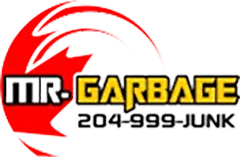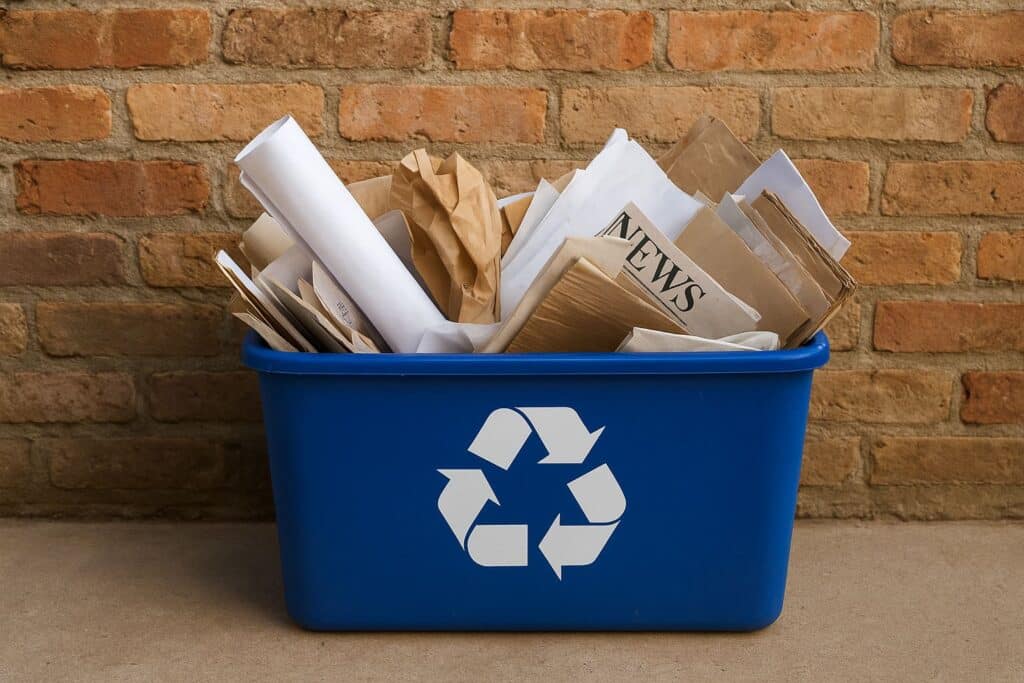Paper is the single most common material in home recycling streams, like newspapers, mail, boxes, and wrapping, all show up at the curb. Done well,
Paper Recycling Winnipeg keeps fibre in local manufacturing loops, protects our sorting equipment from contamination, and reduces pressure on landfills. This guide explains what to put in your blue cart, how shredded paper should be handled, where to drop off larger volumes, how the city processes paper after pickup, and when a local service like Mr. Garbage is a good option.
Where residents can drop off and what’s collected
The City of Winnipeg runs curbside blue-cart collection and several 4R Winnipeg Depots where homeowners can drop off extra paper and cardboard. These depot sites accept a wide range of residential paper products and are a reliable option when your cart overflows or you have bulky boxes to recycle.
Accepted paper in Winnipeg typically includes:
- Newspapers, flyers, magazines, and office paper.
- Mail, envelopes (remove large windows if asked), and paper bags.
- Corrugated cardboard and boxboard (flattened for space).
- Paper egg cartons, paper rolls, and most clean paper packaging.
If you are unsure about a particular item, check the City’s “What goes where” resource. It saves a trip and prevents contamination that can cause entire loads to be rejected at the sorting facility.
How Paper Recycling Winnipeg handles shredded paper and special cases
Shredded paper needs special handling because loose shreds can blow away or jam equipment. In Winnipeg, municipal guidance allows shredded paper to be placed in a clear plastic bag before being placed in the blue cart, which keeps it contained during collection and sorting. If you have large amounts of shredded material, consider bundling or taking it to a depot to avoid problems at the Materials Recovery Facility (MRF).
Gift wrap, tissue paper, and aluminium-backed paper often confuse homeowners. Generally:
- Gift wrapping with glitter, foil, or plastic coating is not recyclable in blue carts.
- Tissue paper and paper towels are not suitable for standard paper recycling due to short fibres and contamination; composting may be a better route if it’s food-free.
- Aluminium laminated papers are usually not recyclable with regular paper; check the item or choose the depot for advice.
When in doubt, check the city’s guide or put the item in a separate bag and ask depot staff. Avoiding contamination is the priority.
What happens to the paper after pickup
After collection, residential recyclables go to Winnipeg’s Materials Recovery Facility (MRF), where paper is separated from containers and other materials. The MRF uses mechanical screens, conveyors, optical sorters, and manual quality-control stations to create clean paper streams ready for baling and shipment to paper processors. GFL operates the local MRF that receives the city’s collected recyclables for sorting and onward shipment.
The main steps are:
- Arrival and tipping: Trucks unload materials into a receiving pit.
- Pre-sorting: large contaminants and bulky items are removed.
- Mechanical separation: screens and air systems separate fibres from containers.
- Manual quality control: workers remove contamination by hand.
- Baling and shipping: clean paper is baled and shipped to mills where fibre is pulped and remade into new paper products.
This chain matters because a small amount of contamination, oil, food, or plastic film can reduce the value of an entire bale or require extra processing. Proper sorting at home keeps the system working.
Why paper recycling matters in Canada (and for Winnipeg)
Paper fibres make up a large share of diverted materials nationally. Recent Canadian diversion data shows paper fibres represent the single largest category of materials diverted from landfill, illustrating the central role paper recycling plays in national waste management efforts. Keeping paper streams clean helps meet local and provincial diversion goals and keeps valuable fibres in circulation.
ppec-paper.comFor Winnipeg homeowners, the benefits are practical:
- Conserves trees and reduces demand for virgin fibre.
- Lowers landfill pressure and reduces greenhouse-gas emissions tied to disposal.
- Supports local recycling markets and processors that rely on steady supplies of clean paper.
Small household behaviours add up: flatten boxes, keep paper dry, and avoid placing food-soiled items in the blue cart. Those steps protect the recycling stream and ensure more material gets reused.
Government of CanadaHow to prepare paper and cardboard for recycling
A short checklist will make your paper recycling more effective:
- Flatten and fold cardboard boxes so they take up less space.
- Keep paper dry; damp paper can stick together and spoil a bale.
- Remove non-paper inserts, large plastic windows, or electronic components.
- Place shredded paper in a clear plastic bag and tie it closed before putting it in the blue cart.
- Avoid bagging other recyclables in plastic — the MRF is built for loose, separated materials.
These easy actions reduce contamination, speed handling, and increase the chance your paper actually gets turned into new products.
Tricky materials explained (gift wrap, tissue, aluminium paper)
Is gift wrapping paper recyclable?
Many types of gift wrap are fine; plain paper gift wrap without foil, glitter, or plastic coating can usually go in the blue cart. But metallic or glitter-covered paper, and gift bags with plastic laminates, are not recyclable in the regular paper stream and should go to the garbage or be reused when possible. When in doubt, tear a small piece and check whether it tears like paper; if it melts or has a shiny plastic feel, recycle elsewhere.
City of WinnipegHow is tissue paper recyclable?
Tissue and paper towels have short, broken fibres and are often contaminated with food or oils. They are not usually accepted in the paper stream and are better suited to composting if clean (and composting is locally accepted), or to the garbage if contaminated. If you have a backyard composter or municipal organics routing that accepts paper towels, that’s the better path.
www150.statcan.gc.caIs aluminium paper recyclable?
Aluminium-foil-backed paper and laminated paper are not recyclable with typical paper because the metal layer cannot be economically separated at the MRF. Small amounts of clean aluminium foil can be recycled in some programs if rolled into a ball, but laminated gift wrap usually must go to the garbage or be repurposed. Check depot guidance for exceptions.
How do you recycle shredded paper in Winnipeg?
Shredded paper is accepted, but it must be contained. The City of Winnipeg’s recycling guide and local depot instructions require shredded paper to be placed in a clear plastic bag and tied closed before placing it in the blue cart. This single exception to the “no plastic bags” rule keeps shreds from scattering and helps the MRF process the material safely. For large quantities, take shredded paper to a depot or use a private service that accepts it in bulk.
Practical tip: Put shredded paper in a cardboard box or a clear bag and mark it “shredded.” This helps depot staff and transportation handlers know how to process it quickly.
Local examples: how Winnipeg households make paper recycling work
A few neighbourhood practices help recycle more paper with less hassle:
- A family in St. James keeps a flattened-box stack in the garage all month and drops overflow at a 4R depot. That habit prevents wet or soggy boxes from ruining the cart.
- An apartment building organizes a monthly cardboard collection day where residents place flattened boxes in a central area; the building manager bundles and takes the load to a depot.
These small habits, a dedicated cardboard stack, clear labeling for shredded paper, and occasional depot trips, make the system efficient and reduce contamination at the MRF.
City of WinnipegExpert perspective: “
Paper fibres are a valuable resource; keeping them clean and dry is the single most effective thing households can do,” says Dr. L. Nguyen, a Canadian waste management consultant. “
Winnipeg’s system works well when residents follow simple preparation rules and use depots when volumes exceed curbside capacity.”
ppec-paper.com
When to use a private service like Mr. Garbage and paper recycling pickups
Public collection handles most residential paper, but private services like Mr. Garbage are useful when:
- You have a large volume: moving, home office clearout, or renovation packaging.
- You prefer a scheduled, curbside-style pickup rather than transporting bulky loads.
- You want a documented chain-of-custody for business or sensitive document shredding and recycling.
Mr. Garbage sorts, bundles, and routes paper and cardboard to approved recycling partners. For shredded documents and sensitive materials, they can coordinate secure handling and ensure the material reaches an appropriate processor. Mentioning Mr. Garbage here is practical: homeowners often opt for a trusted local partner when volumes or convenience make depot visits impractical.
The bigger picture: paper recycling and Canadian diversion goals
Paper recycling contributes significantly to national diversion performance. Paper fibres account for a large portion of diverted materials in Canada, underscoring the importance of household participation. Improving paper recycling quality (less contamination, better sorting) supports local mills and helps Canada meet waste-diversion objectives. Winnipeg’s role in collecting clean paper streams matters for both local processors and national recycling targets.
Community impact: more reliable paper streams mean more local use of recycled fibre in packaging and paper products, which strengthens circular-economy opportunities for Manitoba businesses and organizations.
Conclusion
Paper Recycling Winnipeg is straightforward when you follow a few simple rules: keep paper clean and dry, flatten boxes, contain shredded paper in a clear, tied bag, and use 4R depots when your cart can’t handle the volume. Clean paper keeps mills running and reduces landfill pressure. When private help is more convenient, Mr. Garbage offers pickups, sorting, and secure handling for sensitive documents and bulky loads, a practical option for busy homeowners and larger cleanouts.
Ready to clear out a mountain of boxes or recycle shredded documents securely?
Book a pickup with Mr. Garbage or find your nearest 4R Depot and follow Winnipeg’s recycling rules to keep paper in the circular economy.
Frequently Asked Questions (FAQs)
Q1: What can I put in my blue cart for Paper Recycling Winnipeg?
A: Newspapers, flyers, magazines, mail, office paper, flattened cardboard, and most clean paper packaging. Keep paper dry and remove large non-paper inserts.
Q2: How do I recycle shredded paper in Winnipeg?
A: Place shredded paper in a clear plastic bag, tie it closed, and put it in your blue cart. For large quantities, use a 4R depot or a private pickup.
Q3: Is gift wrapping paper recyclable?
A: Plain paper gift wrap is usually fine. Avoid metallic, glitter, or laminated wrap; these items typically are not recyclable in the regular paper stream.
Q4: What should I do with greasy pizza boxes?
A: Remove clean cardboard sections and recycle those. Heavily soiled portions should be composted if possible or disposed of separately to avoid contaminating paper bales.
Q5: Can Mr. Garbage pick up cardboard and shredded paper for recycling?
A: Yes. Mr. Garbage offers pickup, secure handling for shredded documents, and routing to approved recycling partners for large or awkward loads

